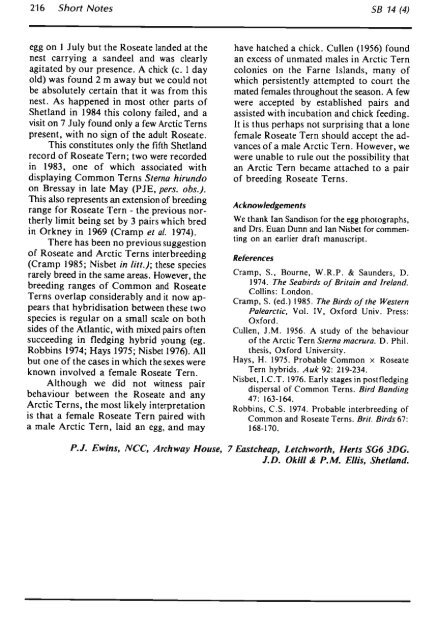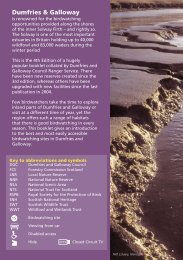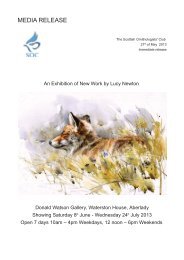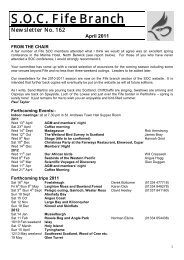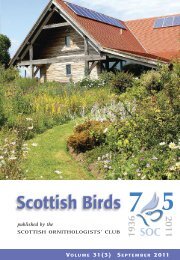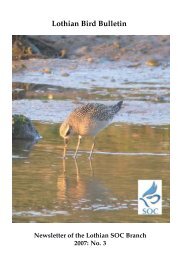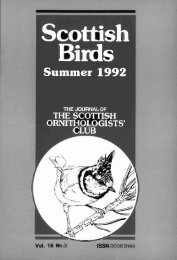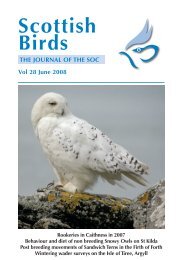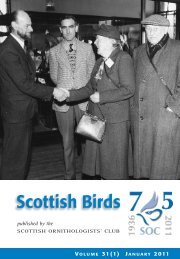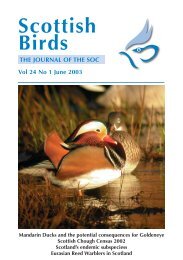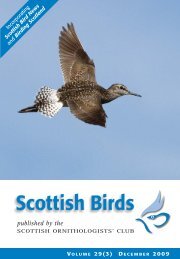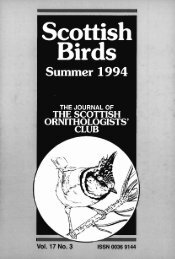V 14 No.4 - The Scottish Ornithologists' Club
V 14 No.4 - The Scottish Ornithologists' Club
V 14 No.4 - The Scottish Ornithologists' Club
Create successful ePaper yourself
Turn your PDF publications into a flip-book with our unique Google optimized e-Paper software.
216 Short Notes<br />
S8 <strong>14</strong> (4)<br />
egg on 1 July but the Roseate landed at the<br />
nest carrying a sandeel and was clearly<br />
agitated by our presence. A chick (c. 1 day<br />
old) was found 2 m away but we could not<br />
be absolutely certain that it was from this<br />
nest. As happened in most other parts of<br />
Shetland in 1984 this colony failed, and a<br />
visit on 7 July found only a few Arctic Terns<br />
present, with no sign of the adult Roseate.<br />
This constitutes only the fifth Shetland<br />
record of Roseate Tern; two were recorded<br />
in 1983, one of which associated with<br />
displaying Common Terns Sterna hirundo<br />
on Bressay in late May (p JE, pers. obs.) .<br />
This also represents an extension of breeding<br />
range for Roseate Tern - the previous northerly<br />
limit being set by 3 pairs which bred<br />
in Orkney in 1969 (Cramp et al. 1974).<br />
<strong>The</strong>re has been no previous suggestion<br />
of Roseate and Arctic Terns interbreeding<br />
(Cramp 1985; Nisbet in litt.); these species<br />
rarely breed in the same areas. However, the<br />
breeding ranges of Common and Roseate<br />
Terns overlap considerably and it now appears<br />
that hybridisation between these two<br />
species is regular on a small scale on both<br />
sides of the Atlantic, with mixed pairs often<br />
succeeding in fledging hybrid young (eg.<br />
Robbins 1974; Hays 1975; Nisbet 1976). All<br />
but one of the cases in which the sexes were<br />
known involved a female Roseate Tern.<br />
Although we did not witness pair<br />
behaviour between the Roseate and any<br />
Arctic Terns, the most likely interpretation<br />
is that a female Roseate Tern paired with<br />
a male Arctic Tern, laid an egg, and may<br />
have hatched a chick. Cullen (1956) found<br />
an excess of unmated males in Arctic Tern<br />
colonies on the Fame Islands, many of<br />
which persistently attempted to court the<br />
mated females throughout the season. A few<br />
were accepted by established pairs and<br />
assisted with incubation and chick feeding.<br />
It is thus perhaps not surprising that a lone<br />
female Roseate Tern should accept the advances<br />
of a male Arctic Tern. However, we<br />
were unable to rule out the possibility that<br />
an Arctic Tern became attached to a pair<br />
of breeding Roseate Terns.<br />
Acknowledgements<br />
We thank lan Sandison for the egg photographs,<br />
and Drs. Euan Dunn and lan Nisbet for commenting<br />
on an earlier draft manuscript.<br />
References<br />
Cramp, S., Bourne, W.R.P. & Saunders, D.<br />
1974. <strong>The</strong> Seabirds of Britain and Ireland.<br />
Collins: London.<br />
Cramp, S. (ed.) 1985. <strong>The</strong> Birds of the Western<br />
Palearctic, Vol. IV, Oxford Univ . Press:<br />
Oxford.<br />
Cullen, J.M. 1956. A study of the behaviour<br />
of the Arctic Tern Sterna macrura. D. Phil.<br />
thesis, Oxford University.<br />
Hays, H. 1975. Probable Common x Roseate<br />
Tern hybrids. Auk 92: 219-234.<br />
Nisbet,I.C.T. 1976. Early stages in postfledging<br />
dispersal of Common Terns. Bird Banding<br />
47: 163-164.<br />
Robbins, C.S. 1974. Probable interbreeding of<br />
Common and Roseate Terns. Brit. Birds 67:<br />
168-170.<br />
P.I. Ewins, Nee, Archway House, 7 £astcheap, Letchworth, Herts SG6 3DG.<br />
I.D. Okill & P.M. Ellis, Shetland.


